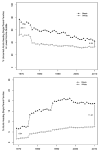Racial Inequality Trends and the Intergenerational Persistence of Income and Family Structure
- PMID: 26456973
- PMCID: PMC4598060
- DOI: 10.1177/0003122414554947
Racial Inequality Trends and the Intergenerational Persistence of Income and Family Structure
Abstract
Racial disparity in family incomes remained remarkably stable over the past 40 years in the United States despite major legal and social reforms. Previous scholarship presents two primary explanations for persistent inequality through a period of progressive change. One highlights continuity: because socioeconomic status is transmitted from parents to children, disparities created through histories of discrimination and opportunity denial may dissipate slowly. The second highlights change: because family income results from joining individual earnings in family units, changing family compositions can offset individuals' changing economic chances. I examine whether black-white family income inequality trends are better characterized by the persistence of existing disadvantage (continuity) or shifting forms of disadvantage (change). I combine cross-sectional and panel analysis using Current Population Survey, Panel Study of Income Dynamics, Census, and National Vital Statistics data. Results suggest that African Americans experience relatively extreme intergenerational continuity (low upward mobility) and discontinuity (high downward mobility); both helped maintain racial inequality. Yet, intergenerational discontinuities allow new forms of disadvantage to emerge. On net, racial inequality trends are better characterized by changing forms of disadvantage than by continuity. Economic trends were equalizing but demographic trends were disequalizing; as family structures shifted, family incomes did not fully reflect labor-market gains.
Keywords: demography; inequality; mobility; race.
Figures









References
-
- Angrist Joshua, Lavy Victor, Schlosser Analia. Multiple Experiments for the Causal Link between the Quantity and Quality of Children. Journal of Labor Economics. 2010;28(4):773–823.
-
- Autor David H, Katz Lawrence F, Kearney Melissa S. The Polarization of the U.S. Labor Market. American Economic Review. 2006;96(2):189–94.
-
- Beller Emily. Bringing Intergenerational Social Mobility Research into the Twenty-first Century: Why Mothers Matter. American Sociological Review. 2009;74(4):507–528.
-
- Bennett Neil, Bloom David, Craig Patricia. The Divergence of Black and White Marriage Patterns. American Journal of Sociology. 1989;95(3):692–722.
Grants and funding
LinkOut - more resources
Full Text Sources
Other Literature Sources
Miscellaneous
